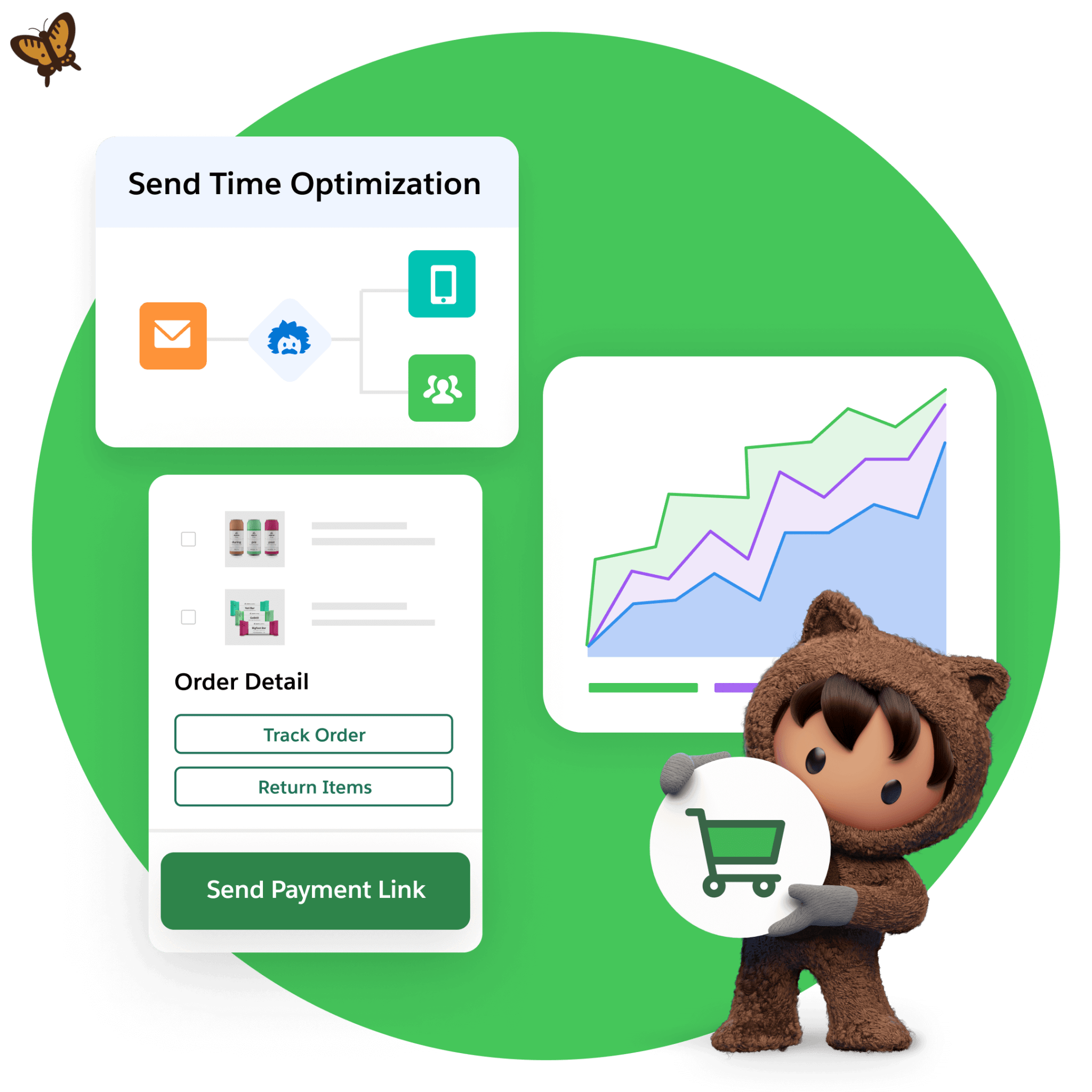Looking to grow your small or medium-sized business (SMB) without the burden of managing inventory, loading the boxes, or running to UPS to ship? Dropshipping could be your secret weapon.
We’ll explore what dropshipping is, how it works, and why it’s becoming a favorite among entrepreneurs. We’ll also show you how a customer relationship management (CRM) system can enhance your dropshipping operations, making it easier to connect with customers and suppliers. Whether you’re just starting out or aiming to scale, this guide will help you navigate the ins and outs of dropshipping and leverage a CRM (hint hint: with the power of artificial intelligence (AI) just a tad) to achieve your goals.
What we’ll cover:
- What is dropshipping?
- Is dropshipping good for small businesses?
- How dropshipping works
- Tools and platforms for dropshipping
- Common challenges with dropshipping and how to overcome them
- How Salesforce supports small ecommerce businesses
What is dropshipping?
Dropshipping is a retail fulfillment method where the seller does not keep products in stock. Instead, when a customer places an order, the seller purchases the item from a third-party supplier, who then ships it directly to the customer. This setup means the seller never handles the product directly.
If you’re new to ecommerce, dropshipping can be one of the easiest ways to get started. It’s a retail model that removes many of the headaches that come with traditional online selling — like managing inventory or hiring a fulfillment team.
And when you connect dropshipping with powerful tools like customer relationship management (CRM), you get a full system to scale — one that supports your marketing, sales, customer service, and even automates everyday tasks with AI.
Sell More With Salesforce For Small Business
How does dropshipping work?
At its core, dropshipping is a simple partnership: You set up an online storefront, promote your products, and take customer orders. Your supplier — not you — handles the inventory, packaging, shipping, returns, and restocking. Everything flows from your store to the supplier and then to your customer.
One of the biggest advantages of dropshipping is that you never have to hold inventory. That means no need to purchase products in advance, rent storage space, pay for bulk deliveries, worry about unsold stock, or manage restocks manually.
Because everything is shipped directly from your supplier to your customer, your business can run lean and stay flexible. You’ll save time and avoid the complexity that often slows down first-time online sellers.
The role of the supplier
Suppliers are more than just order shippers — they’re the operational arm of your business. A strong supplier handles product sourcing, inventory storage, quality control, order fulfillment, delivery tracking, and returns management. The best ones also offer branded packaging, real-time inventory updates, dedicated account support, and integrations with ecommerce platforms.
The role of the business owner
You’re not just running an online shop — you’re building a full digital brand. Your responsibilities span five or more areas: store design, customer communication, marketing, relationship management, and data analysis. You’ll also coordinate supplier relationships and use CRM insights to personalize outreach and drive loyalty.
Dropshipping vs. traditional retail
Traditional retail involves purchasing large quantities of inventory ahead of time, storing that inventory in a warehouse, hiring people to manage shipping, tracking and fulfilling orders manually, and handling returns yourself. This model requires a high upfront investment and physical space to operate.
Dropshipping flips that script. With no inventory to manage, you can:
- Launch your store faster
- Lower your initial costs
- Reduce overhead and risk
- Test multiple product categories
- Adapt to market trends in real time
Benefits of dropshipping for small businesses
If you’re a new entrepreneur or a small business owner exploring ecommerce, dropshipping offers some standout benefits:
- No warehousing or fulfillment: Suppliers manage the entire order process, so you don’t have to pick or ship anything.
- Lower upfront investment: You don’t need to buy inventory in advance, so you can get started with fewer financial risks.
- Easy to experiment with new products: Add or remove items from your store without worrying about leftover stock or waste.
- Flexible and scalable: You can sell across different regions, expand your product range, test new markets, and grow without needing a bigger team.
- Faster go-to-market strategy: Instead of waiting weeks or months to source, stock, and prepare, you can launch and iterate quickly.
Start selling online with Starter Suite
Set up your digital storefront, engage customers, and sell more using a commerce-ready platform with integrated tools for every sale.

Is dropshipping good for small businesses?
For many small businesses like yours, dropshipping is an attractive option. It’s particularly beneficial for entrepreneurs who want to get into ecommerce without taking on too much upfront risk or dealing with the complexities of traditional retail.
Low barrier to entry
One of the main advantages of dropshipping is the low barrier to entry. Traditional retail often requires significant capital upfront to purchase inventory and set up infrastructure for warehousing and fulfillment. With dropshipping, you can bypass these expenses entirely. All you need is an internet connection and a website. This is especially valuable for:
- New entrepreneurs testing the waters of ecommerce with limited budgets
- Small startups aiming to break into the market without risking too much initial capital
- Established online retailers seeking to diversify their product offerings without committing to high volumes of inventory
Flexible and cost-effective
Dropshipping offers flexibility and cost savings for growing businesses — but it comes with trade-offs. In a traditional retail setup, you purchase and store inventory upfront, which can tie up your resources and create risk if products don’t sell. With dropshipping, the supplier handles storage and shipping — and you only pay when an order is placed.
However, this convenience comes at a cost. Dropshipping suppliers typically charge a service fee or keep a portion of the sale price, which can lower your profit margins. Some charge a flat rate per item, while others use a percentage-based model depending on the product category or shipping complexity. It’s important to factor these fees into your pricing strategy to protect your ROI.
- Test new products: Since you’re not investing in bulk inventory, you can quickly try out new products to see what resonates with customers — without a big financial risk.
- Adapt to market trends: Whether it’s a seasonal change or a sudden shift in consumer demand, dropshipping allows you to adjust your product range quickly and without financial risk.
- Scalable growth: As your business grows, you can scale operations easily by adding more products or suppliers, and you don’t have to worry about physical storage or fulfillment space.
Grow Your Small Business With AI Agents
Learn how autonomous AI can scale your small business for efficient growth in our free e-book.

Fast go-to-market strategy
When you’re looking to establish your online presence quickly, dropshipping can help you launch your business in no time. Without the burden of sourcing inventory or setting up fulfillment processes, you can focus on creating a professional store and attracting your target audience.
- Set up your online store: With modern ecommerce platforms, creating a store is simpler than ever. You don’t need complex coding skills to design a site that looks and feels professional.
- Add products instantly: You can integrate your store with a wide range of suppliers, adding new products with just a few clicks. There’s no need to wait weeks or months for stock to arrive.
- Market and sell: Once your products are listed, you can begin marketing your store through social media, search engine optimization (SEO), and online advertising to start generating sales almost immediately.
How dropshipping works: Step by step
Dropshipping may look straightforward, but a strong backend setup — with the right supplier relationships and automation tools — is what keeps everything running smoothly. The process follows a clear flow that helps store owners sell without stocking or shipping products themselves.
Step 1: A customer places an order on your online store
You got an order! After browsing your online storefront, a shopper selects a product, proceeds to checkout, and places an order. You’re not holding inventory or processing the shipment, but you are the seller of record. Your ecommerce platform and CRM work together to confirm the sale, process payment, and record customer details.
Step 2: The order details are sent to your supplier
Once the order is received, details are automatically sent to your chosen supplier. This includes the product SKU, quantity, delivery address, payment confirmation, and shipping preference. Some systems also allow you to customize packaging and tracking alerts, even though you’re not shipping the product yourself.
Webinar: Unlocking Growth: AI and Tech Strategies for SMB Success in 2025
Step 3: The supplier packs and ships the product
The supplier steps in to fulfill the order. They pick the product from their inventory, pack it using their shipping materials, apply labels, and dispatch it directly to the customer. Good suppliers offer tracking, delivery notifications, branded packaging, returns processing, and shipping support across domestic and international zones.
Step 4: You manage marketing, service, and performance
Even though you’re not touching the product, you still own the customer relationship. That means you handle everything from sales emails, order updates, and customer support to loyalty campaigns and experience feedback. Your role includes using CRM data and marketing automation to build trust, increase repeat purchases, drive referrals, and reduce churn.
Tools and platforms for dropshipping
The right tools can help you run your dropshipping business like a pro. While your suppliers handle fulfillment, you’ll still need powerful systems to manage orders and grow your store. These tools cover everything from product sourcing to customer retention.
Ecommerce storefront
Start with a platform that allows you to create and customize your online store without needing to code. Look for builders that support responsive design, multiple product categories, secure checkouts, mobile optimization, real-time inventory sync, and CRM integrations. A flexible storefront helps you adapt quickly as customer expectations and product offerings evolve.
Supplier directory
Reliable supplier directories help you discover and compare hundreds of potential partners. These platforms usually offer supplier reviews, fulfillment details, shipping timelines, communication tools, and integration options for popular ecommerce builders. Using directories helps reduce risk and gives you access to vetted suppliers who can scale with your growth.
Inventory and order management tool
To avoid overselling or delays, use tools that track stock levels, update product availability, manage SKUs, sync across sales channels, and notify customers when orders ship. The best systems also include analytics dashboards, backorder alerts, automated invoicing, shipping label generation, and customer support integrations to reduce manual work.
A unified commerce CRM
Salesforce supports small business dropshipping by connecting ecommerce, sales, marketing, and service in one platform. You can use it to manage customer records, personalize journeys, automate outreach, monitor performance, and unify data from multiple tools. With AI support and automation, it becomes easier to improve retention, upsell effectively, reduce churn, and grow sustainably.
Wherever you are — just get started.
No matter where you are on your journey as a business owner, you can get started with Starter Suite for free — the CRM made for growth.

Common challenges with dropshipping and how to overcome them
Dropshipping lets you start selling fast without inventory, but delays and errors can hurt customer trust. Knowing the risks early helps you avoid problems as you grow.
Challenge: Shipping delays from overseas or inconsistent suppliers can frustrate customers.
Solution: Choose suppliers with fast shipping, regional warehouses, real-time tracking, and clear delay policies.
Challenge: Inventory mismatches and overselling risk lead to cancellations and lost sales.
Solution: Use live inventory syncing, low-stock alerts, and CRM tools to pause unavailable items and notify customers.
Challenge: Inconsistent product quality harms your store’s reputation.
Solution: Vet suppliers through samples, packaging checks, and clear return processes, then track issues with your CRM.
Challenge: Lack of communication about order status reduces customer trust.
Solution: Use automated notifications to keep customers updated on shipping and delays throughout the buying process.
How Salesforce supports small ecommerce businesses
Growing a dropshipping business takes more than just good products. To stand out, you need connected systems that help you manage orders and adapt quickly to change. That’s where Salesforce comes in — offering tools designed for small businesses that need to move fast and scale smart.
Launch quickly with digital storefronts
Getting your online store off the ground shouldn’t require a developer or months of setup. With Salesforce’s commerce tools, SMBs can design responsive storefronts and customize product pages — without a lot of technical experience.
You can easily update pricing, test promotions, create new landing pages, and track performance across four or more key metrics: traffic, conversions, average order value, and cart abandonment.
Build customer relationships with CRM integration
The most successful dropshipping businesses treat every customer interaction as an opportunity to grow loyalty. Salesforce brings your sales history, service conversations, marketing campaigns, and AI insights into one place — so you can personalize your service and wow your customers. This CRM integration helps your team deliver more consistent experiences across email, chat, SMS, and social.
Get a complete view of every sale in one place
When you sell across multiple platforms or work with several suppliers, it’s easy for data to become fragmented. Salesforce gives you a unified dashboard that shows product availability, order status, fulfillment timelines, shipping delays, and open service requests. This visibility helps you reduce errors, simplify workflows, forecast demand, and deliver better support — all from one single place.
Automate and simplify daily operations with AI
Manual processes slow you down and increase the risk of missed opportunities. With Salesforce AI, you can automate inventory alerts, customer follow-ups, abandoned cart messages, loyalty campaigns, and service escalations. AI tools can also surface high-value leads, flag negative sentiment in messages, generate personalized responses, and recommend next steps based on customer behavior.
Ready to begin dropshipping? We’ve got you covered
Dropshipping offers a low-risk way to launch and grow your online store — but only if you’re equipped with the right tools and strategy. For small business owners juggling a lot, it creates a unique opportunity to scale fast.
With a CRM to unify your dropshipping needs — and AI to help you make faster, smarter decisions — you can turn a simple storefront into a scalable ecommerce business.
Start your journey with the Starter Suite today. Looking for more customization? Explore Pro Suite. Already a Salesforce customer? Activate Foundations and try out Agentforce 360 today.
AI supported the writers and editors who created this article.
Learn how to get your AI agents up and running
Grab the new (free!) e-book 5 Steps to Implementing AI Agents for Small Businesses and scale fast.

Thank you!
SuccessFrequently Asked Questions (FAQs)
Absolutely. Dropshipping is one of the easiest ways to launch your online store without spending much upfront. You don’t need to buy inventory or rent storage space — just set up your storefront and start selling. With the right tools, even a limited budget can go far.
Your supplier is the backbone of your dropshipping business. Look for partners who offer fast shipping, quality products, reliable tracking, and great support. Always test a few products yourself before adding them to your store — that way, you know exactly what your customers will receive.
Dropshipping usually comes with lower margins than traditional retail, since you’re paying suppliers for fulfillment. But with smart pricing, efficient tools, and a CRM to help you stay organized, you can build a profitable business. Over time, you’ll learn which products and suppliers give you the best return.
It can be both. Dropshipping is a great way for you to test products or start your store quickly. But with the right systems in place — like AI-powered CRM tools and strong supplier relationships — you can scale your business and turn it into a long-term, sustainable venture.
A CRM gives you one place to manage your customers, suppliers, marketing, and service. When you add AI, you can automate tasks like follow-ups and campaign emails. That means less time on busywork and more time focusing on growth — and giving your customers a better experience.

































